Applied Economics Report: Australian Beef Market Analysis and Policy
VerifiedAdded on 2022/12/29
|10
|1682
|1
Report
AI Summary
This report provides an economic analysis of the beef market, examining the effects of various factors on its dynamics. It begins by illustrating how drought impacts beef prices using demand and supply models, followed by an analysis of the COVID-19 pandemic's influence on beef prices. The report then explores the impact of drought-breaking rains on cattle beef prices. Furthermore, it identifies and discusses the price elasticity of demand for beef in Australia, examining the determinants affecting it. The report also illustrates how falling beef prices affect the total revenue generated by beef farmers. Finally, it identifies and examines the effects of imposing GST on beef, explaining the elasticity implications and evaluating economists' views on GST introduction on food products. The report concludes by summarizing the key findings related to the elasticity of demand and the impact of government policies like GST on the beef market.
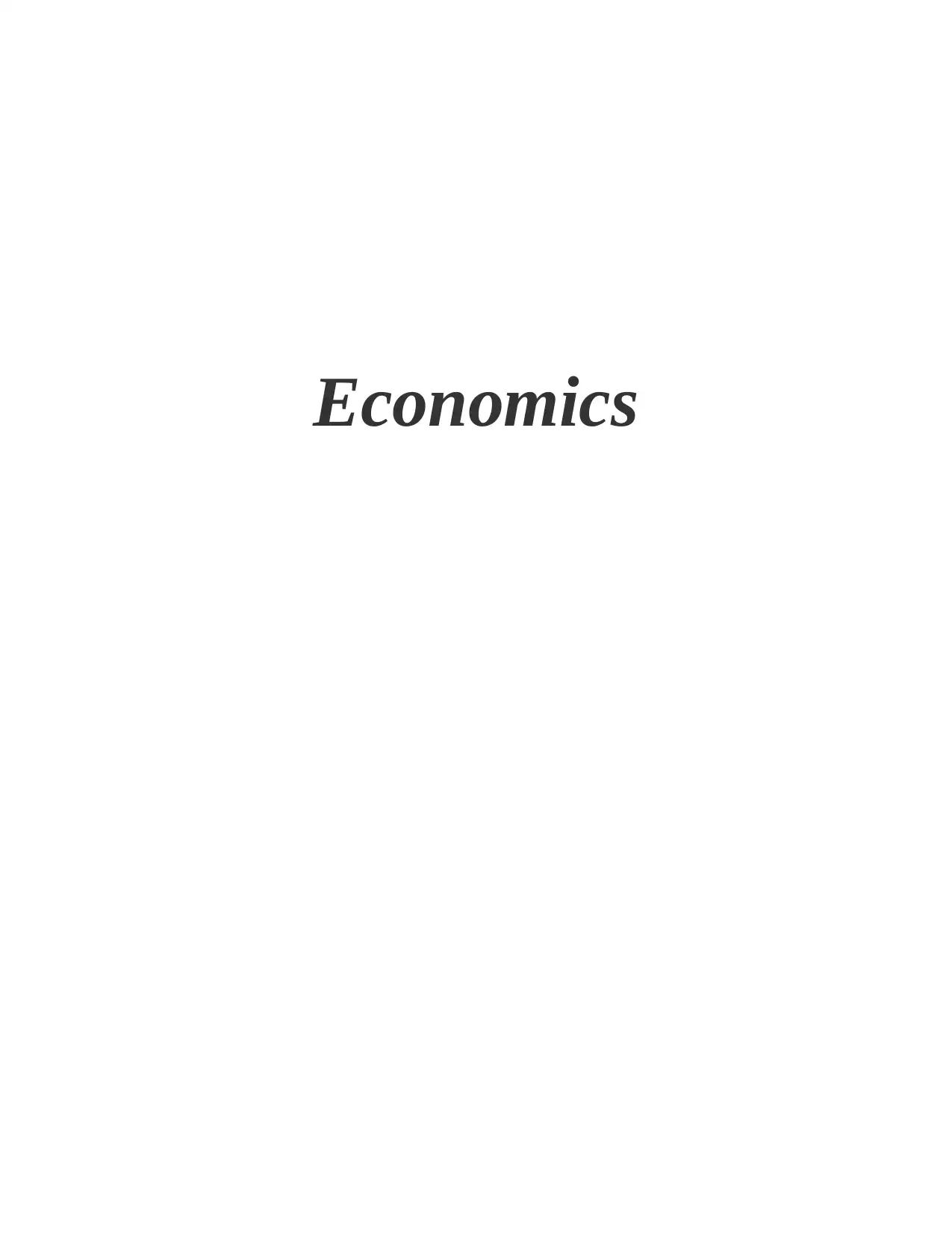
Economics
Paraphrase This Document
Need a fresh take? Get an instant paraphrase of this document with our AI Paraphraser
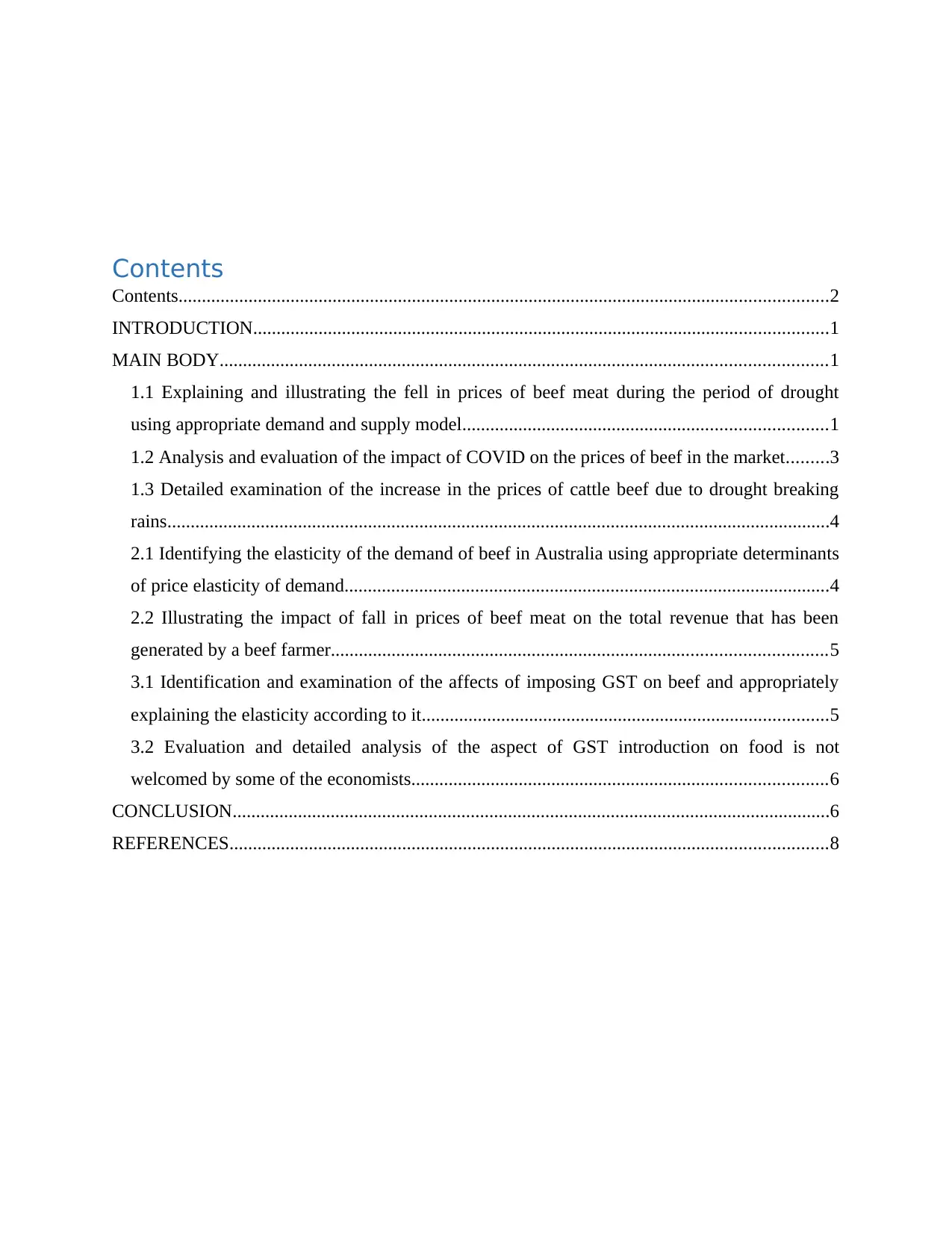
Contents
Contents...........................................................................................................................................2
INTRODUCTION...........................................................................................................................1
MAIN BODY..................................................................................................................................1
1.1 Explaining and illustrating the fell in prices of beef meat during the period of drought
using appropriate demand and supply model..............................................................................1
1.2 Analysis and evaluation of the impact of COVID on the prices of beef in the market.........3
1.3 Detailed examination of the increase in the prices of cattle beef due to drought breaking
rains..............................................................................................................................................4
2.1 Identifying the elasticity of the demand of beef in Australia using appropriate determinants
of price elasticity of demand........................................................................................................4
2.2 Illustrating the impact of fall in prices of beef meat on the total revenue that has been
generated by a beef farmer..........................................................................................................5
3.1 Identification and examination of the affects of imposing GST on beef and appropriately
explaining the elasticity according to it.......................................................................................5
3.2 Evaluation and detailed analysis of the aspect of GST introduction on food is not
welcomed by some of the economists.........................................................................................6
CONCLUSION................................................................................................................................6
REFERENCES................................................................................................................................8
Contents...........................................................................................................................................2
INTRODUCTION...........................................................................................................................1
MAIN BODY..................................................................................................................................1
1.1 Explaining and illustrating the fell in prices of beef meat during the period of drought
using appropriate demand and supply model..............................................................................1
1.2 Analysis and evaluation of the impact of COVID on the prices of beef in the market.........3
1.3 Detailed examination of the increase in the prices of cattle beef due to drought breaking
rains..............................................................................................................................................4
2.1 Identifying the elasticity of the demand of beef in Australia using appropriate determinants
of price elasticity of demand........................................................................................................4
2.2 Illustrating the impact of fall in prices of beef meat on the total revenue that has been
generated by a beef farmer..........................................................................................................5
3.1 Identification and examination of the affects of imposing GST on beef and appropriately
explaining the elasticity according to it.......................................................................................5
3.2 Evaluation and detailed analysis of the aspect of GST introduction on food is not
welcomed by some of the economists.........................................................................................6
CONCLUSION................................................................................................................................6
REFERENCES................................................................................................................................8

INTRODUCTION
Economics is a social science of human behaviour that deals in allocating the resources in
such a manner so that the consumer can maximise their level of satisfaction, producer can
maximise the level of profit, while society can maximise its welfare (Banzhaf, Ma and Timmins,
2019). In this report there is a brief discussion of the cattle beef and the changes in its demand
and supply due to various aspects including drought, COVID, etc. Apart from this the report also
covers a brief examination and explanation of the elasticity of demand and the possible effect
and impact of Goods and Service Tax (GST) on cattle beef. Further in this report elasticity of
beef meat in a country like Australia is also elaborated in a systematic and sequential manner.
MAIN BODY
1.1 Explaining and illustrating the fell in prices of beef meat during the period of drought using
appropriate demand and supply model
Since equilibrium is a state of rest position in which two forces that is demand and supply
becomes equal where there is no tendency to change and it is regarded as a position in economics
where both demand and supply curve tends to be at the same position and thus price is
determined because of that.
Economics is a social science of human behaviour that deals in allocating the resources in
such a manner so that the consumer can maximise their level of satisfaction, producer can
maximise the level of profit, while society can maximise its welfare (Banzhaf, Ma and Timmins,
2019). In this report there is a brief discussion of the cattle beef and the changes in its demand
and supply due to various aspects including drought, COVID, etc. Apart from this the report also
covers a brief examination and explanation of the elasticity of demand and the possible effect
and impact of Goods and Service Tax (GST) on cattle beef. Further in this report elasticity of
beef meat in a country like Australia is also elaborated in a systematic and sequential manner.
MAIN BODY
1.1 Explaining and illustrating the fell in prices of beef meat during the period of drought using
appropriate demand and supply model
Since equilibrium is a state of rest position in which two forces that is demand and supply
becomes equal where there is no tendency to change and it is regarded as a position in economics
where both demand and supply curve tends to be at the same position and thus price is
determined because of that.
⊘ This is a preview!⊘
Do you want full access?
Subscribe today to unlock all pages.

Trusted by 1+ million students worldwide
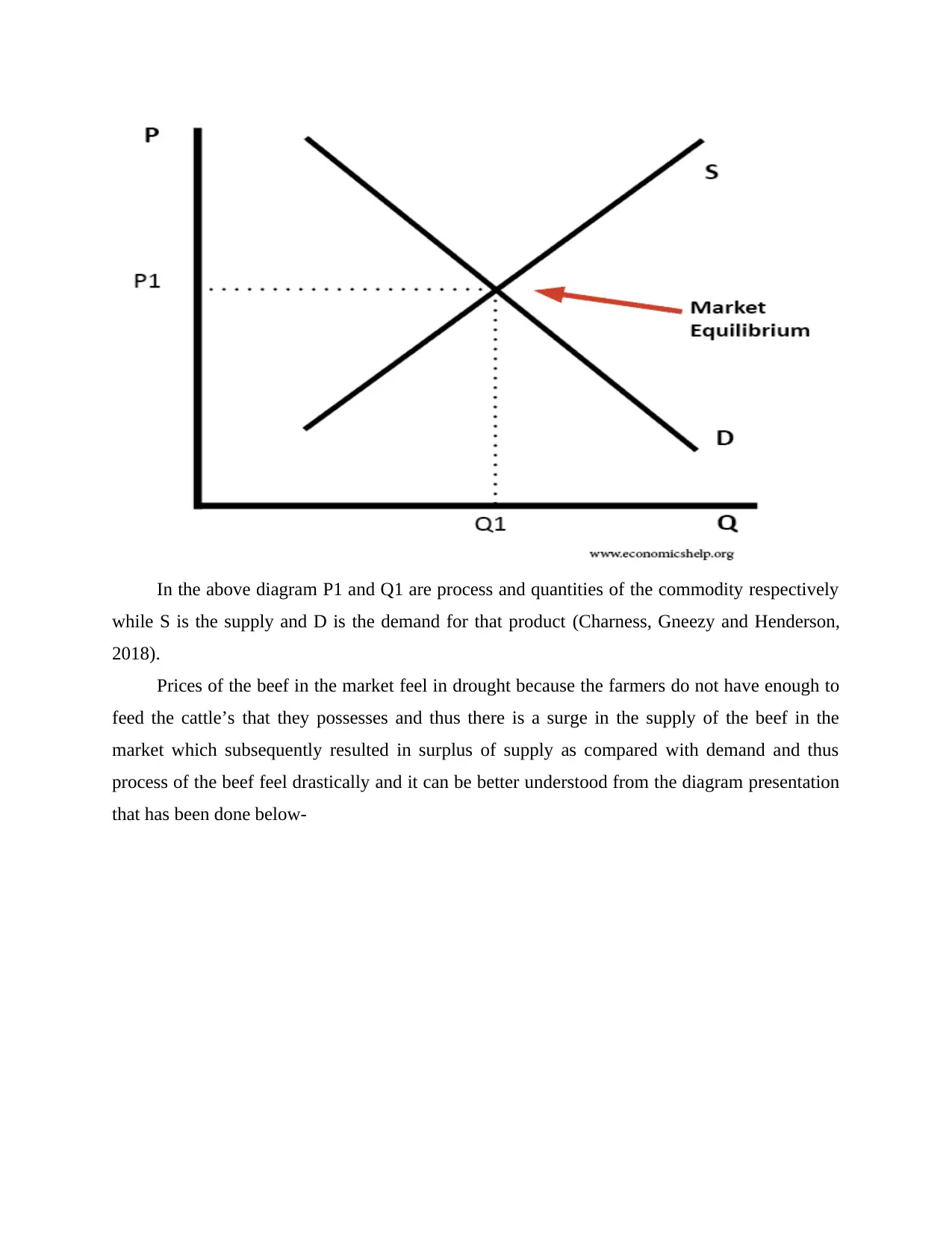
In the above diagram P1 and Q1 are process and quantities of the commodity respectively
while S is the supply and D is the demand for that product (Charness, Gneezy and Henderson,
2018).
Prices of the beef in the market feel in drought because the farmers do not have enough to
feed the cattle’s that they possesses and thus there is a surge in the supply of the beef in the
market which subsequently resulted in surplus of supply as compared with demand and thus
process of the beef feel drastically and it can be better understood from the diagram presentation
that has been done below-
while S is the supply and D is the demand for that product (Charness, Gneezy and Henderson,
2018).
Prices of the beef in the market feel in drought because the farmers do not have enough to
feed the cattle’s that they possesses and thus there is a surge in the supply of the beef in the
market which subsequently resulted in surplus of supply as compared with demand and thus
process of the beef feel drastically and it can be better understood from the diagram presentation
that has been done below-
Paraphrase This Document
Need a fresh take? Get an instant paraphrase of this document with our AI Paraphraser
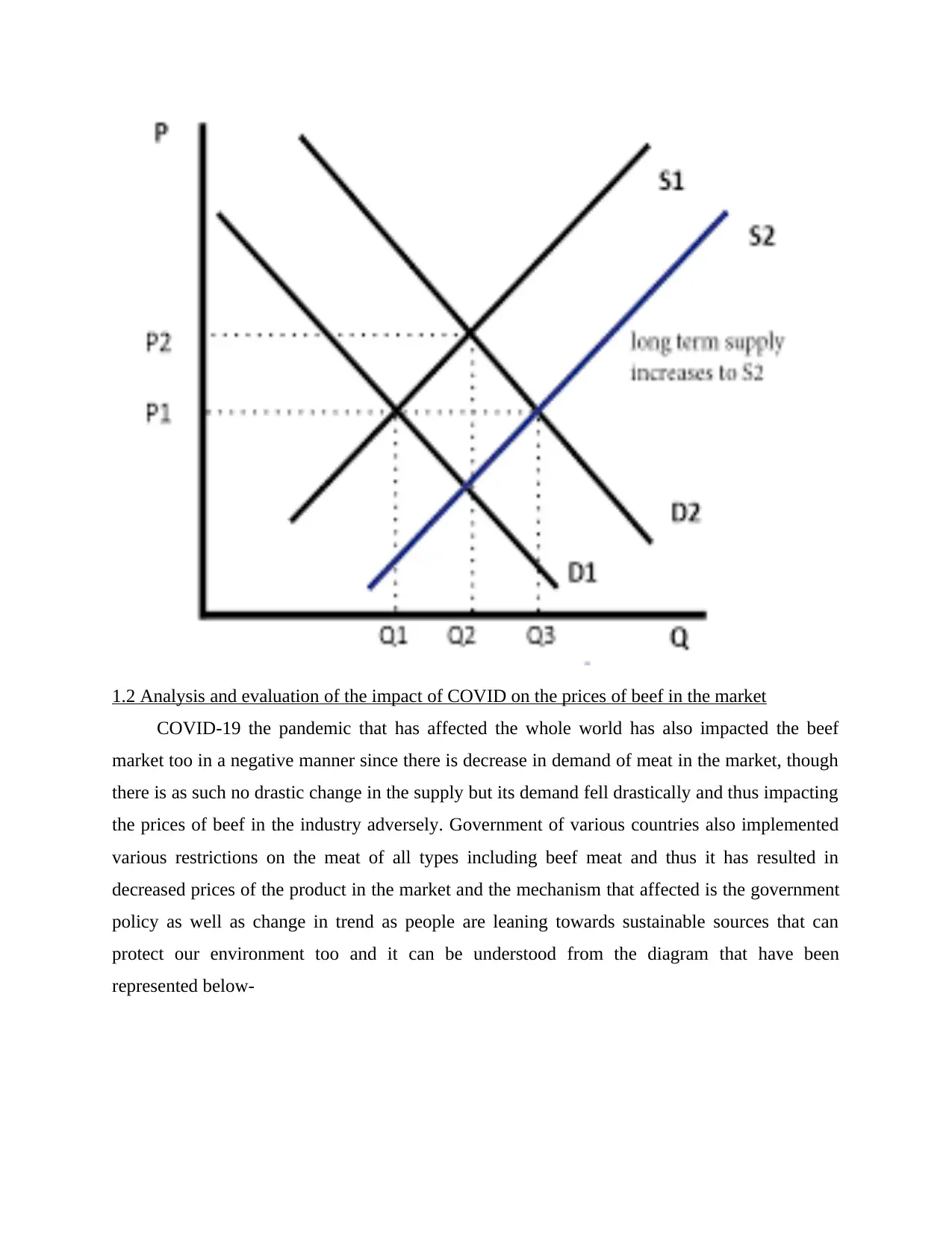
1.2 Analysis and evaluation of the impact of COVID on the prices of beef in the market
COVID-19 the pandemic that has affected the whole world has also impacted the beef
market too in a negative manner since there is decrease in demand of meat in the market, though
there is as such no drastic change in the supply but its demand fell drastically and thus impacting
the prices of beef in the industry adversely. Government of various countries also implemented
various restrictions on the meat of all types including beef meat and thus it has resulted in
decreased prices of the product in the market and the mechanism that affected is the government
policy as well as change in trend as people are leaning towards sustainable sources that can
protect our environment too and it can be understood from the diagram that have been
represented below-
COVID-19 the pandemic that has affected the whole world has also impacted the beef
market too in a negative manner since there is decrease in demand of meat in the market, though
there is as such no drastic change in the supply but its demand fell drastically and thus impacting
the prices of beef in the industry adversely. Government of various countries also implemented
various restrictions on the meat of all types including beef meat and thus it has resulted in
decreased prices of the product in the market and the mechanism that affected is the government
policy as well as change in trend as people are leaning towards sustainable sources that can
protect our environment too and it can be understood from the diagram that have been
represented below-
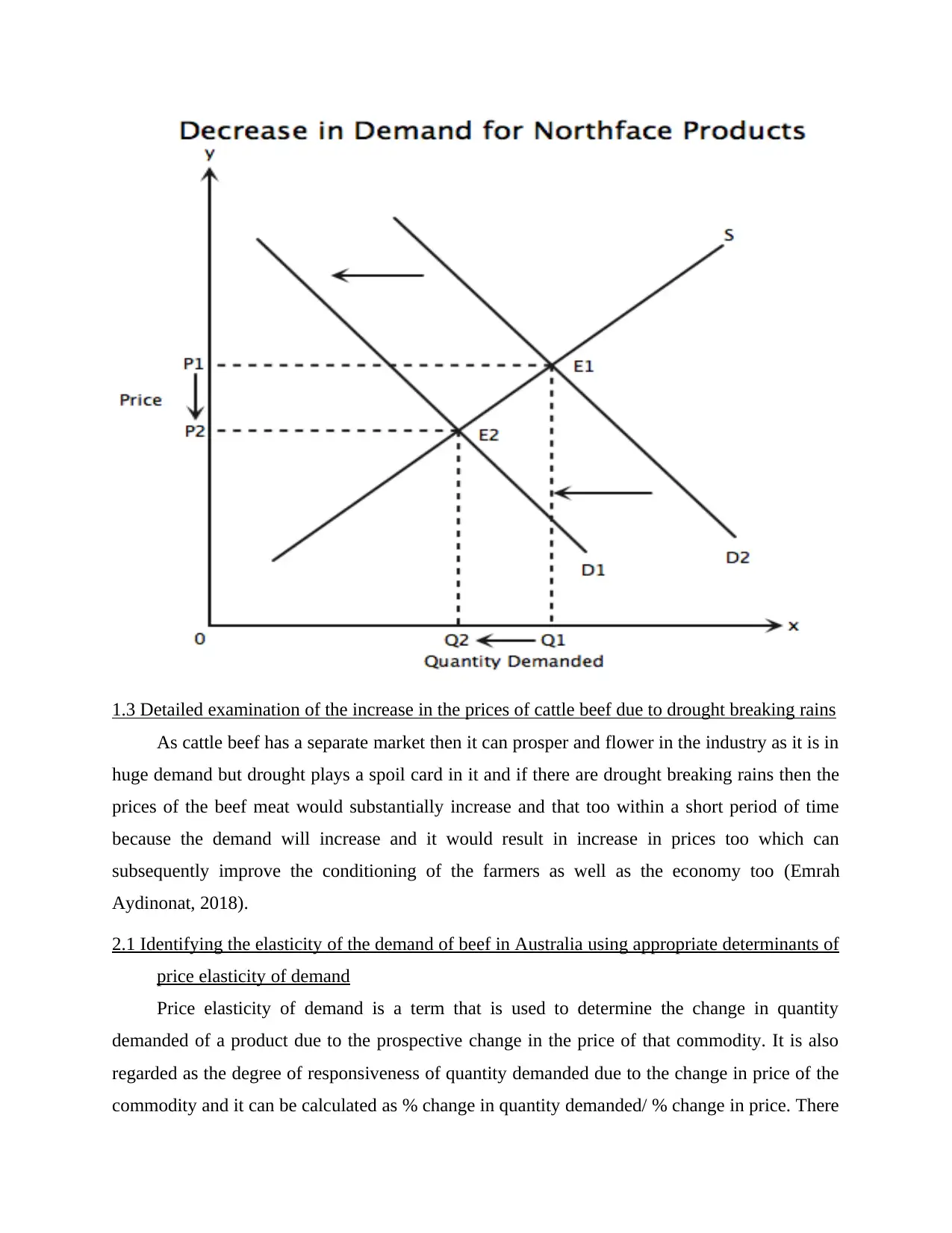
1.3 Detailed examination of the increase in the prices of cattle beef due to drought breaking rains
As cattle beef has a separate market then it can prosper and flower in the industry as it is in
huge demand but drought plays a spoil card in it and if there are drought breaking rains then the
prices of the beef meat would substantially increase and that too within a short period of time
because the demand will increase and it would result in increase in prices too which can
subsequently improve the conditioning of the farmers as well as the economy too (Emrah
Aydinonat, 2018).
2.1 Identifying the elasticity of the demand of beef in Australia using appropriate determinants of
price elasticity of demand
Price elasticity of demand is a term that is used to determine the change in quantity
demanded of a product due to the prospective change in the price of that commodity. It is also
regarded as the degree of responsiveness of quantity demanded due to the change in price of the
commodity and it can be calculated as % change in quantity demanded/ % change in price. There
As cattle beef has a separate market then it can prosper and flower in the industry as it is in
huge demand but drought plays a spoil card in it and if there are drought breaking rains then the
prices of the beef meat would substantially increase and that too within a short period of time
because the demand will increase and it would result in increase in prices too which can
subsequently improve the conditioning of the farmers as well as the economy too (Emrah
Aydinonat, 2018).
2.1 Identifying the elasticity of the demand of beef in Australia using appropriate determinants of
price elasticity of demand
Price elasticity of demand is a term that is used to determine the change in quantity
demanded of a product due to the prospective change in the price of that commodity. It is also
regarded as the degree of responsiveness of quantity demanded due to the change in price of the
commodity and it can be calculated as % change in quantity demanded/ % change in price. There
⊘ This is a preview!⊘
Do you want full access?
Subscribe today to unlock all pages.

Trusted by 1+ million students worldwide
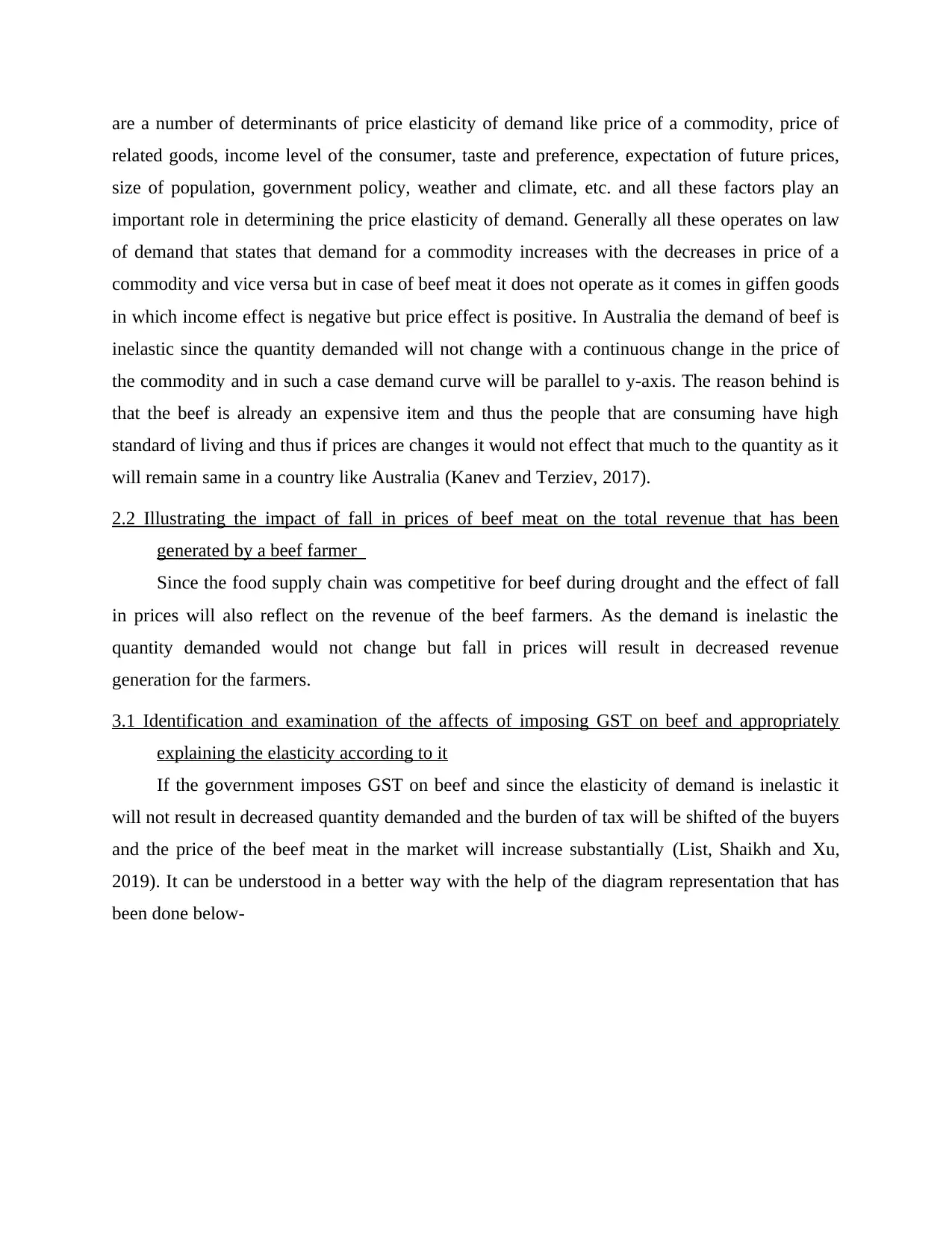
are a number of determinants of price elasticity of demand like price of a commodity, price of
related goods, income level of the consumer, taste and preference, expectation of future prices,
size of population, government policy, weather and climate, etc. and all these factors play an
important role in determining the price elasticity of demand. Generally all these operates on law
of demand that states that demand for a commodity increases with the decreases in price of a
commodity and vice versa but in case of beef meat it does not operate as it comes in giffen goods
in which income effect is negative but price effect is positive. In Australia the demand of beef is
inelastic since the quantity demanded will not change with a continuous change in the price of
the commodity and in such a case demand curve will be parallel to y-axis. The reason behind is
that the beef is already an expensive item and thus the people that are consuming have high
standard of living and thus if prices are changes it would not effect that much to the quantity as it
will remain same in a country like Australia (Kanev and Terziev, 2017).
2.2 Illustrating the impact of fall in prices of beef meat on the total revenue that has been
generated by a beef farmer
Since the food supply chain was competitive for beef during drought and the effect of fall
in prices will also reflect on the revenue of the beef farmers. As the demand is inelastic the
quantity demanded would not change but fall in prices will result in decreased revenue
generation for the farmers.
3.1 Identification and examination of the affects of imposing GST on beef and appropriately
explaining the elasticity according to it
If the government imposes GST on beef and since the elasticity of demand is inelastic it
will not result in decreased quantity demanded and the burden of tax will be shifted of the buyers
and the price of the beef meat in the market will increase substantially (List, Shaikh and Xu,
2019). It can be understood in a better way with the help of the diagram representation that has
been done below-
related goods, income level of the consumer, taste and preference, expectation of future prices,
size of population, government policy, weather and climate, etc. and all these factors play an
important role in determining the price elasticity of demand. Generally all these operates on law
of demand that states that demand for a commodity increases with the decreases in price of a
commodity and vice versa but in case of beef meat it does not operate as it comes in giffen goods
in which income effect is negative but price effect is positive. In Australia the demand of beef is
inelastic since the quantity demanded will not change with a continuous change in the price of
the commodity and in such a case demand curve will be parallel to y-axis. The reason behind is
that the beef is already an expensive item and thus the people that are consuming have high
standard of living and thus if prices are changes it would not effect that much to the quantity as it
will remain same in a country like Australia (Kanev and Terziev, 2017).
2.2 Illustrating the impact of fall in prices of beef meat on the total revenue that has been
generated by a beef farmer
Since the food supply chain was competitive for beef during drought and the effect of fall
in prices will also reflect on the revenue of the beef farmers. As the demand is inelastic the
quantity demanded would not change but fall in prices will result in decreased revenue
generation for the farmers.
3.1 Identification and examination of the affects of imposing GST on beef and appropriately
explaining the elasticity according to it
If the government imposes GST on beef and since the elasticity of demand is inelastic it
will not result in decreased quantity demanded and the burden of tax will be shifted of the buyers
and the price of the beef meat in the market will increase substantially (List, Shaikh and Xu,
2019). It can be understood in a better way with the help of the diagram representation that has
been done below-
Paraphrase This Document
Need a fresh take? Get an instant paraphrase of this document with our AI Paraphraser
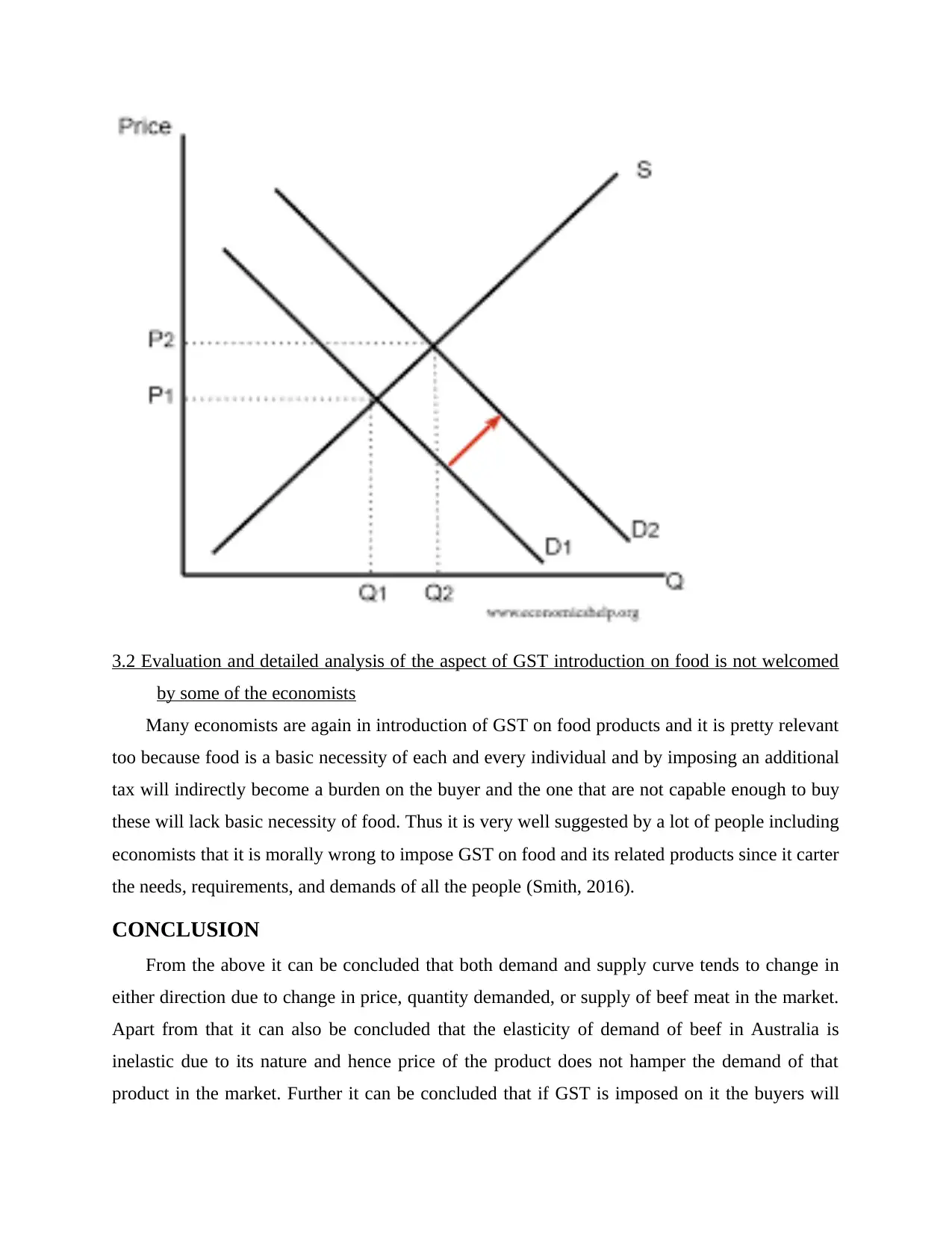
3.2 Evaluation and detailed analysis of the aspect of GST introduction on food is not welcomed
by some of the economists
Many economists are again in introduction of GST on food products and it is pretty relevant
too because food is a basic necessity of each and every individual and by imposing an additional
tax will indirectly become a burden on the buyer and the one that are not capable enough to buy
these will lack basic necessity of food. Thus it is very well suggested by a lot of people including
economists that it is morally wrong to impose GST on food and its related products since it carter
the needs, requirements, and demands of all the people (Smith, 2016).
CONCLUSION
From the above it can be concluded that both demand and supply curve tends to change in
either direction due to change in price, quantity demanded, or supply of beef meat in the market.
Apart from that it can also be concluded that the elasticity of demand of beef in Australia is
inelastic due to its nature and hence price of the product does not hamper the demand of that
product in the market. Further it can be concluded that if GST is imposed on it the buyers will
by some of the economists
Many economists are again in introduction of GST on food products and it is pretty relevant
too because food is a basic necessity of each and every individual and by imposing an additional
tax will indirectly become a burden on the buyer and the one that are not capable enough to buy
these will lack basic necessity of food. Thus it is very well suggested by a lot of people including
economists that it is morally wrong to impose GST on food and its related products since it carter
the needs, requirements, and demands of all the people (Smith, 2016).
CONCLUSION
From the above it can be concluded that both demand and supply curve tends to change in
either direction due to change in price, quantity demanded, or supply of beef meat in the market.
Apart from that it can also be concluded that the elasticity of demand of beef in Australia is
inelastic due to its nature and hence price of the product does not hamper the demand of that
product in the market. Further it can be concluded that if GST is imposed on it the buyers will
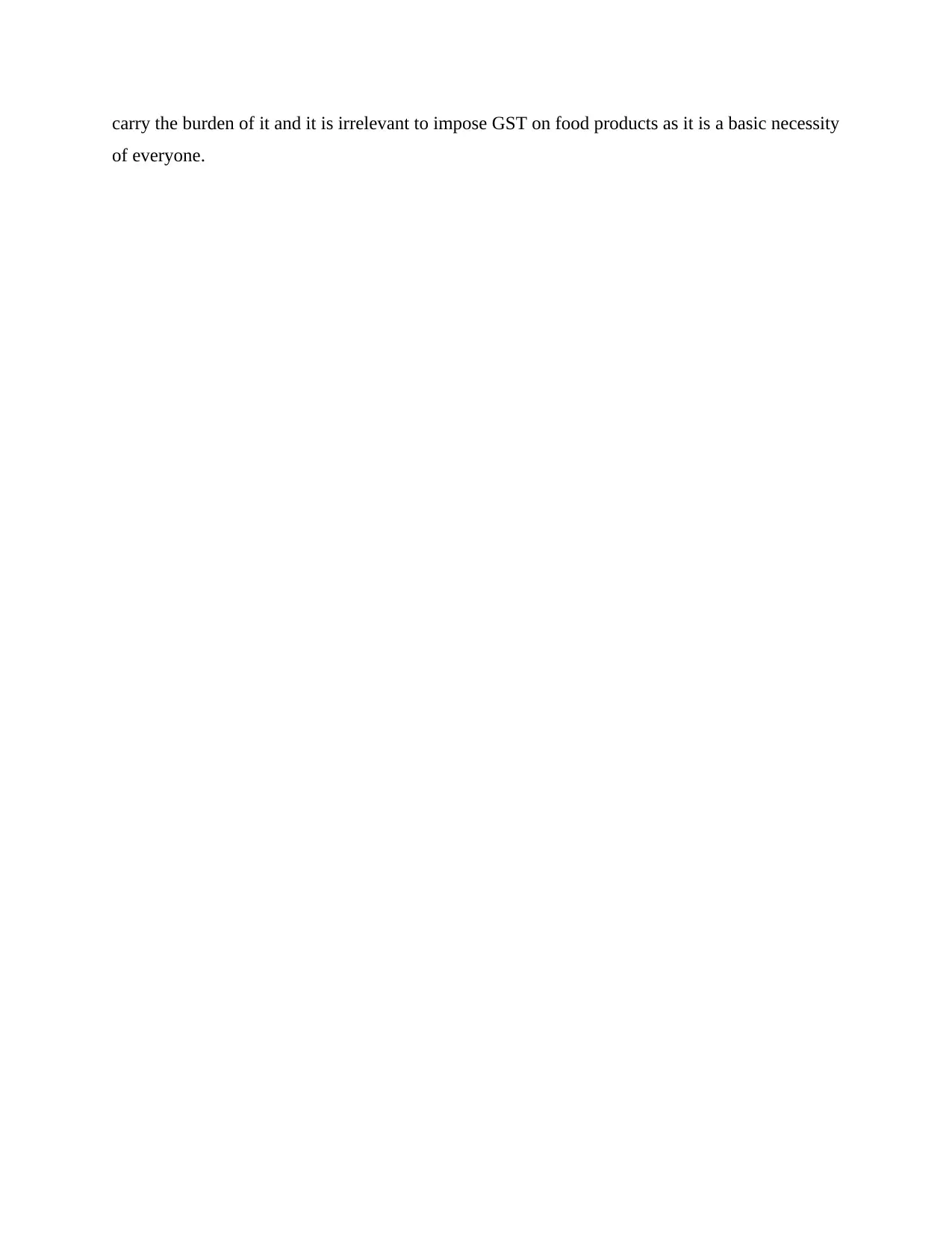
carry the burden of it and it is irrelevant to impose GST on food products as it is a basic necessity
of everyone.
of everyone.
⊘ This is a preview!⊘
Do you want full access?
Subscribe today to unlock all pages.

Trusted by 1+ million students worldwide
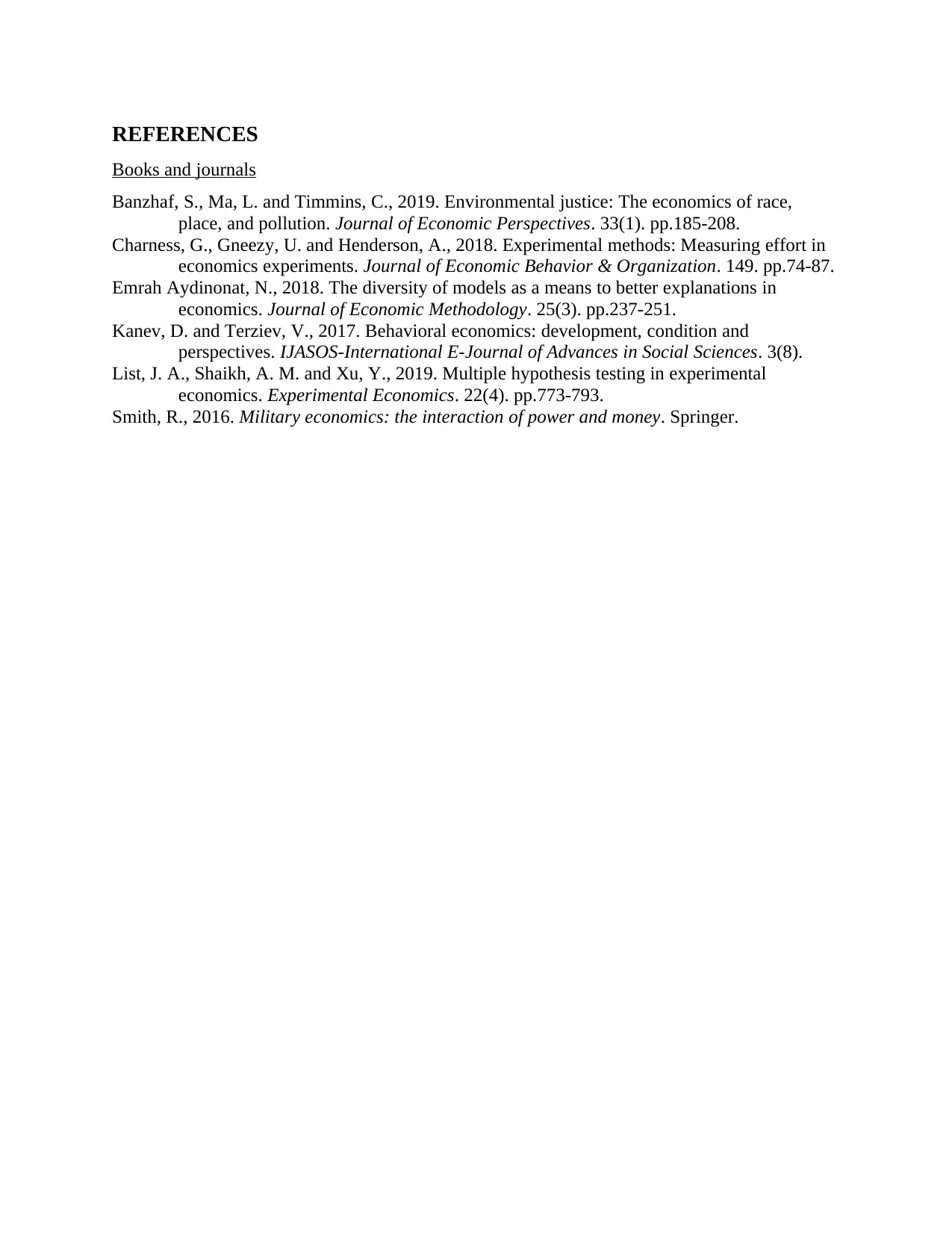
REFERENCES
Books and journals
Banzhaf, S., Ma, L. and Timmins, C., 2019. Environmental justice: The economics of race,
place, and pollution. Journal of Economic Perspectives. 33(1). pp.185-208.
Charness, G., Gneezy, U. and Henderson, A., 2018. Experimental methods: Measuring effort in
economics experiments. Journal of Economic Behavior & Organization. 149. pp.74-87.
Emrah Aydinonat, N., 2018. The diversity of models as a means to better explanations in
economics. Journal of Economic Methodology. 25(3). pp.237-251.
Kanev, D. and Terziev, V., 2017. Behavioral economics: development, condition and
perspectives. IJASOS-International E-Journal of Advances in Social Sciences. 3(8).
List, J. A., Shaikh, A. M. and Xu, Y., 2019. Multiple hypothesis testing in experimental
economics. Experimental Economics. 22(4). pp.773-793.
Smith, R., 2016. Military economics: the interaction of power and money. Springer.
Books and journals
Banzhaf, S., Ma, L. and Timmins, C., 2019. Environmental justice: The economics of race,
place, and pollution. Journal of Economic Perspectives. 33(1). pp.185-208.
Charness, G., Gneezy, U. and Henderson, A., 2018. Experimental methods: Measuring effort in
economics experiments. Journal of Economic Behavior & Organization. 149. pp.74-87.
Emrah Aydinonat, N., 2018. The diversity of models as a means to better explanations in
economics. Journal of Economic Methodology. 25(3). pp.237-251.
Kanev, D. and Terziev, V., 2017. Behavioral economics: development, condition and
perspectives. IJASOS-International E-Journal of Advances in Social Sciences. 3(8).
List, J. A., Shaikh, A. M. and Xu, Y., 2019. Multiple hypothesis testing in experimental
economics. Experimental Economics. 22(4). pp.773-793.
Smith, R., 2016. Military economics: the interaction of power and money. Springer.
1 out of 10
Related Documents
Your All-in-One AI-Powered Toolkit for Academic Success.
+13062052269
info@desklib.com
Available 24*7 on WhatsApp / Email
![[object Object]](/_next/static/media/star-bottom.7253800d.svg)
Unlock your academic potential
Copyright © 2020–2025 A2Z Services. All Rights Reserved. Developed and managed by ZUCOL.





